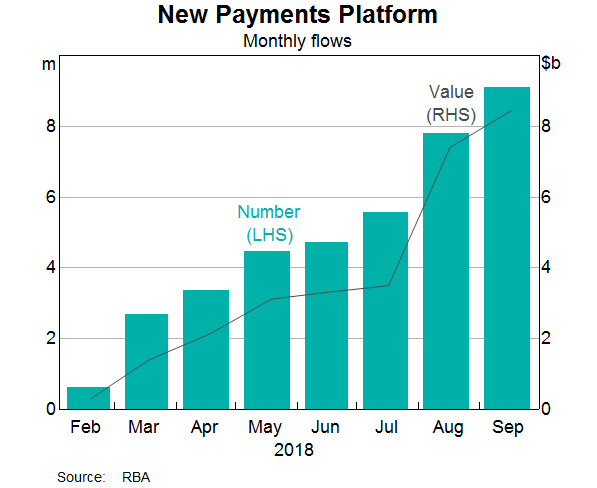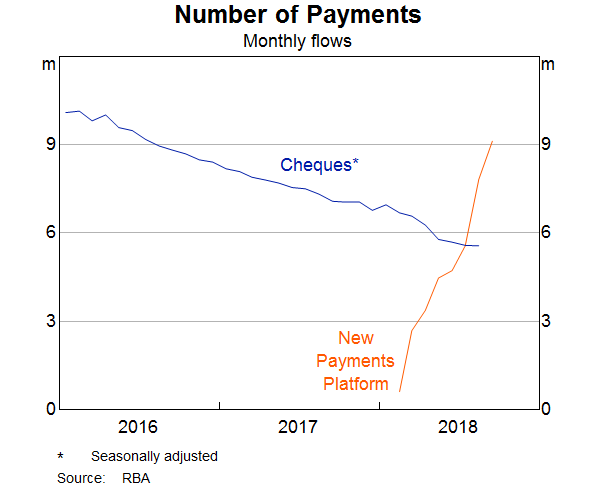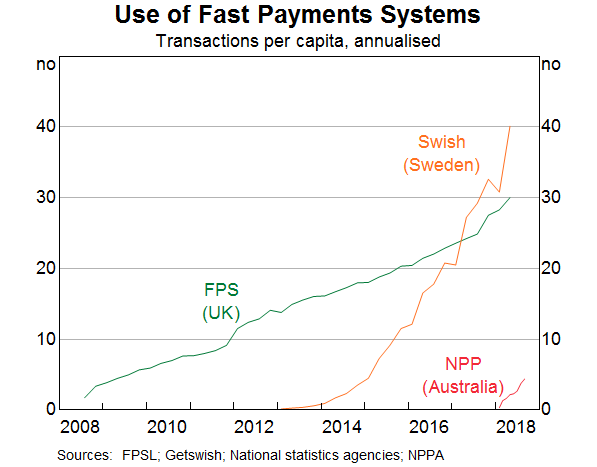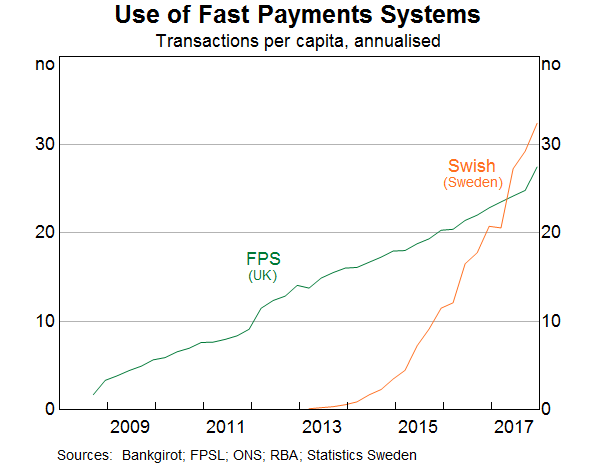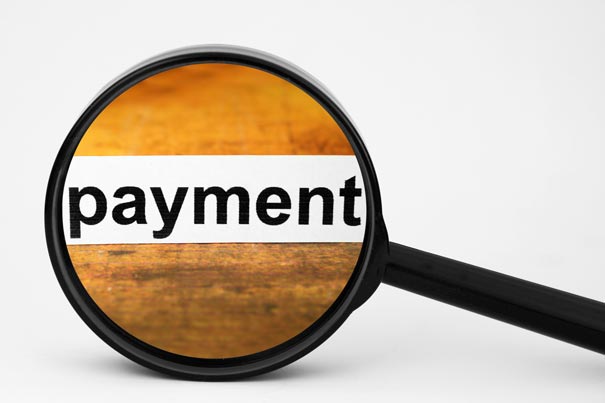Governor Lowe spoke at the Australian Payments Network Summit yesterday. He discussed the rise of electronic transactions, especially though the New Payments Platform, the high relative costs of international retail payments, and the need for, and potential of a Strong Digital Identity System. He also highlighted the decline in cash transactions which now accounts for just around a quarter of day-to-day payments.

A recurring theme across these summits has been the need to improve customer outcomes. I am very pleased to see that this focus has been continued at this year’s summit. The focus on customer outcomes aligns very closely with the focus of the Payments System Board. The Board wants to see a payments system that is innovative, dynamic, secure, competitive, and that serves the needs of all Australians.
Increasingly, this means that the payments system needs to support Australia’s digital economy. With the digital economy being an important key to Australia’s future economic prosperity, we need a payments system that is fit for purpose. We will only fully capitalise on the fantastic opportunities out there if we have a payments system that works for the digital economy. The positive news is that we have made some substantial progress in this direction over recent years and in some areas, Australia’s payments system is world class. However, in the fast-moving world of payments, things don’t stand still and there are some important areas we need to work on.
In my remarks today, I would like to do three things.
The first is to talk about some of the progress that has been made over recent years.
The second is to highlight a few areas where we would like to see more progress, particularly around payments and the digital economy.
And third, I will highlight some of the questions we will explore in next year’s review of retail payments regulation in Australia.
Progress Is Being Made
Over recent years there have been significant changes in the way that we make payments. We now have greater choice than ever before and payments are faster and more flexible than they used to be.
The launch of the New Payments Platform – the NPP – in early 2018 has been an important part of this journey. This new payments infrastructure allows consumers and businesses to make real-time, 24/7 payments with richer data and simple addressing using PayIDs.
After the NPP was launched, it got off to a slow start, but it is now hitting its stride. Monthly transaction values and volumes have both tripled over the past year (Graph 1). In November, the platform processed an average of 1.1 million payments each day, worth about $1.1 billion. The rate of take-up of fast retail payments in Australia is a little quicker than that in most other countries that have also introduced fast payments (Graph 2).
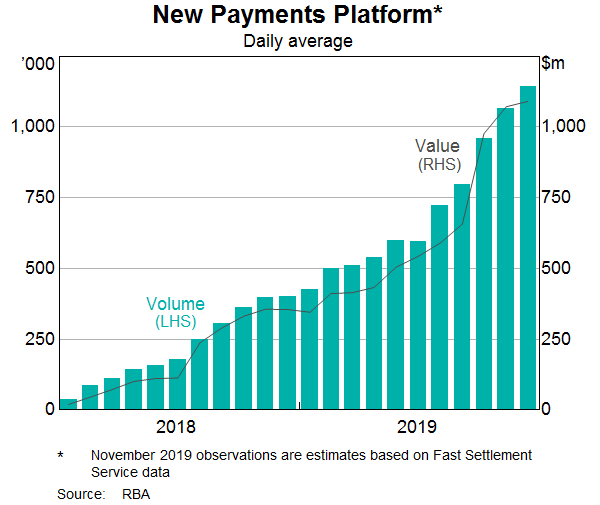
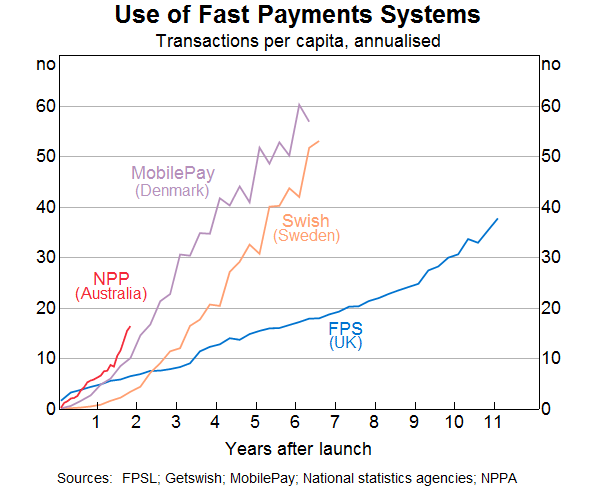
I expect that we will see a further pickup in usage once the CBA has delivered on core NPP functionality for all its customers. The slow implementation has been disappointing and we expect the required functionality to be available soon.
There are now 86 entities connected to the NPP, including 74 that are indirectly connected via a direct NPP participant. There are at least six non-ADI fintechs that are using the NPP’s capabilities to innovate and provide new services to customers. All up, approximately 66 million Australian bank accounts are now able to make and receive NPP payments.
Use of the PayID service has also been growing, with around 3.8 million PayIDs having been registered to date. If you have not already got a PayID, I encourage you to get one. I also encourage you to ask for other people’s PayIDs when making payments, as an alternative to asking for their BSB and account number. It is much easier and faster.
One specific example of where the NPP is bringing direct benefits to people is its use by the Australian Government, supported by the banking arm of the RBA, to make emergency payments. During the current bushfires, the government has been able to use the NPP to make immediate payments to people at a time when they are most in need, whether that be on the weekend or after their bank has shut for the night.
One other area of the payments system where we have seen significant change is the take-up of ‘tap-and-go’ payments. Around 80 per cent of point-of-sale transactions are now ‘tap-and-go’, which is a much higher share than in most other countries. This growth has been made possible by the acquirers rolling out new technology in their terminals and by the willingness of Australians to try something different. There has also been rapid take-up of mobile payments, including through wearable devices.
Progress has also been made on improving the safety of electronic payments, particularly in relation to fraud in card-not-present transactions. The rate of fraud is still too high, but it has come down recently (Graph 3). I would like to acknowledge the work that AusPayNet has done here to develop a new framework to tackle fraud. This framework strengthens the authentication requirements for certain types of transactions, including through the use of multi-factor authentication.[1] This will help reduce card-not-present fraud and support the continued growth in online commerce.
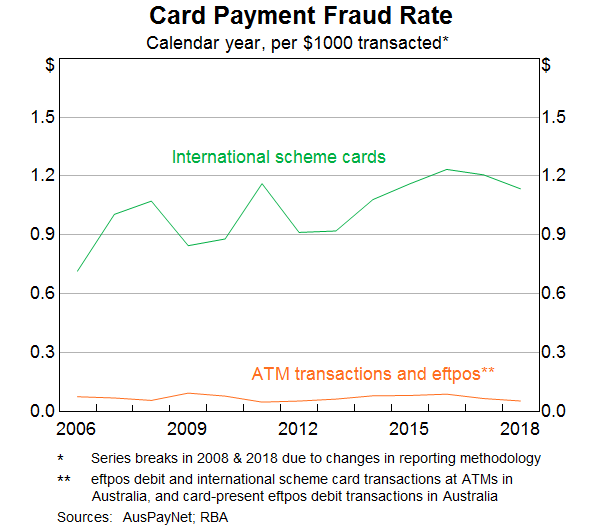
As our electronic payments system continues to improve, we are seeing a further shift away from cash and cheques. The RBA recently undertook the latest wave of our three-yearly consumer payments survey. We are still processing the results, but ahead of publishing them early next year, I thought I would show you the latest estimate on the use of cash (Graph 4). As expected, there has been a further trend decline in the use of cash, with cash now accounting for just around a quarter of day-to-day transactions, and most of these are for small-value payments. Given the other innovations that I just spoke about, I expect that this trend will continue.
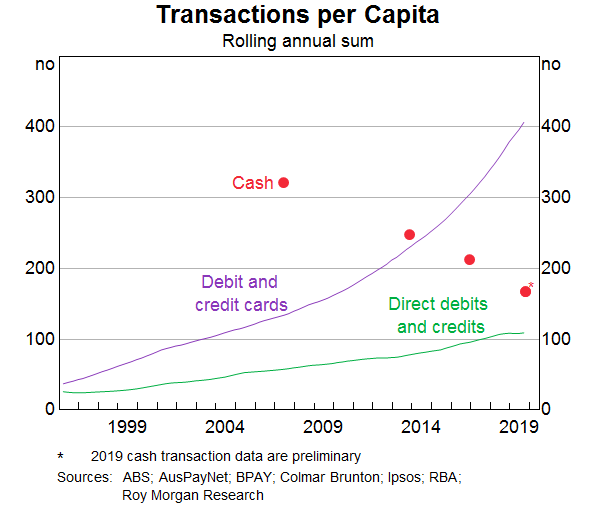
Further Progress Needed
The progress across these various fronts means that there is a positive story to be told about innovation in Australia’s payments system.
At the same time, though, there are still some significant gaps and areas in our payments system that need addressing and where progress would support the digital economy in Australia. I would like to talk about four of these.
NPP
The first of these is further industry work to realise the full potential of the NPP, including its data-rich capabilities.
The NPP infrastructure can help make electronic invoicing commonplace and help invoices be paid on time. It can also support significant improvement in business processes, as more data moves with the payment. Real-time settlement and posting of funds also enables some types of delivery-versus-payment, so that the seller can confirm receipt of funds and be confident in delivering goods or services to the buyer.
The layered architecture of the system was designed to promote competition and innovation in the development of new overlay services. Notwithstanding this, one of the consequences of the slower-than-promised rollout of the NPP by some of the major banks is that there has been less effort than expected on developing innovative functionality. Payment systems are networks, and participants need to know that others will be ready to receive payments and use the network. Some banks have been reluctant to commit time and funding to support the development of new functionality given that others have been slow to roll out their ‘day 1’ functionality. The slow rollout has also reduced the incentive for fintechs and others to develop new ideas. So we have not yet benefited from the full network effects.
The Payments System Board considered this issue as part of its industry consultation on NPP access and functionality, conducted with the ACCC earlier this year. As part of that review we recommended that NPPA – the industry-owned company formed to establish and operate the NPP – publish a roadmap and timeline for the additional functionality that it has agreed to develop. The inaugural roadmap was published in October and NPPA also introduced a ‘mandatory compliance framework’. Under this compliance framework, NPPA can designate core capabilities that NPP participants must support within a specified period of time, with penalties for non-compliance. This is a welcome development.
One important element of the roadmap is the development of a ‘mandated payments service’ to support recurring and ‘debit-like’ payments. This new service will allow account-holders to establish and manage standing authorisations (or consents) for payments to be initiated from their account by third parties. This will provide convenience, transparency and security for recurring or subscription-type payments and a range of other payments.
Another element of the roadmap that has the potential to promote the digital economy is the development of NPP message standards for payroll, tax, superannuation and e-invoicing payments. The standards will define the specific data elements that must be included with these payment types, which will support automation and straight-through processing. We would expect financial institutions to be competing with each other to enable their customers to make and receive these data-rich payments.
Less positively, there is still uncertainty about the future of the two remaining services that were expected to be part of the initial suite of Osko overlay services. These are the ‘request-to-pay’ and ‘payment with document’ services. We understand there are still challenges in securing committed project funding and priority from NPP participants to move ahead, even though BPAY has indicated it is ready to complete the rollout. The RBA strongly supports the development of these additional NPP capabilities, which are likely to deliver significant value for businesses and the broader community.
Digital identity
A second area where the Payments System Board would like to see further progress is the provision of portable digital identity services that allow Australians to securely prove who they are in the digital environment.
Today, our digital identity system is fragmented and siloed, which has resulted in a proliferation of identity credentials and passwords. This gives rise to security vulnerabilities and creates significant inconvenience and inefficiencies, which can undermine development of the digital economy. These generate compliance risks and other costs for financial institutions, so it is strongly in their interests to make progress here. It is fair to say that a number of other countries are well ahead of us in this area.
The Australian Payments Council has recognised the importance of this issue and has developed the ‘TrustID’ framework. The Government’s Digital Transformation Agency has also been working on a complementary framework (the Trusted Digital Identity Framework), which specifies how digital identity services will be used to access online government services. The challenge now is to build on these frameworks and develop a strong digital identity ecosystem in Australia with competing but interoperable digital identity services.
The rollout of open banking and the consumer data right should bring additional competition among financial services providers, and digital identity is likely to reduce the scope for identity fraud, while providing convenient authentication, as part of an open banking regime.
A strong digital identity system would also open up new areas of digital commerce and help reduce online payments fraud. It will also help build trust in a wide range of online interactions. Building this trust is increasingly important as people spend more of their time and money online. So we would like to see some concrete solutions developed and adopted here.
Cross-border retail payments
A third area where we would like to see more progress is on reducing the cost of cross-border payments.
For many people, the costs here are still too high and the payments are still too hard to make. It is important that we address this. It is an issue not just for Australians, but for our neighbours as well. I recently chaired a meeting of the Governors from the South Pacific central banks, where I heard first-hand about the problems caused by the high cost of cross-border payments.
Analysis by the World Bank indicates that the price of sending money from Australia has been consistently higher than the average price across the G20 countries (Graph 5). And a recent ACCC inquiry found that prices for cross-border retail payment services are opaque. Customers are not always aware of how the ‘retail’ exchange rate they are being quoted compares with the wholesale exchange rate they see on the news, or of the final amount that will be received in foreign currency.[2] There are also sometimes add-on fees.[3]
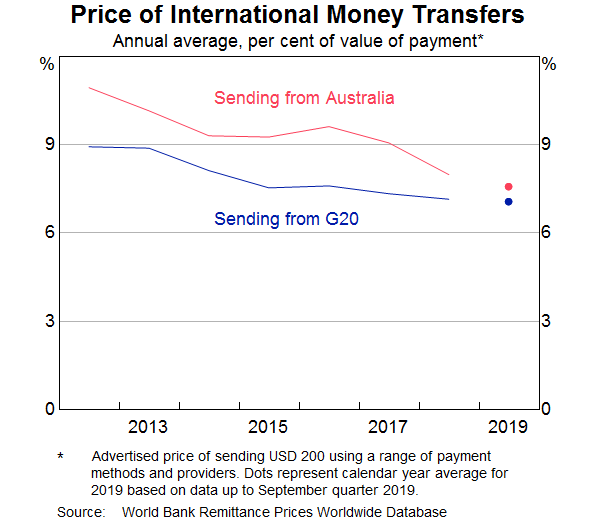
As part of the RBA’s monitoring of the marketplace, our staff recently conducted a form of online shadow shopping exercise, exploring the pricing of international money transfer services by both banks and some of the new non-bank digital money transfer operators (MTOs).
This exercise showed that there is a very wide range of prices across providers and highlighted the importance of shopping around.
The main results are summarised in this graph (Graph 6). In nearly every case, the major banks are more expensive than the digital MTOs. For the major banks, the average mark-up over the wholesale exchange rate is around 5½ per cent, versus about 1 per cent for the digital MTOs.
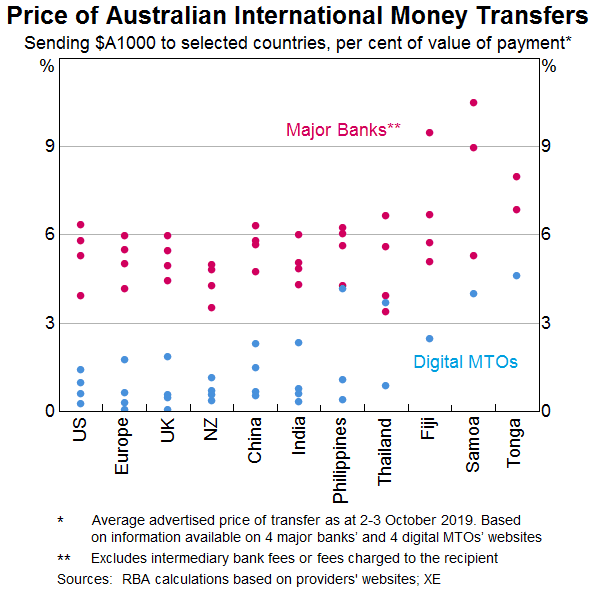
The graph illustrates why the cost of cross-border payments is such an issue for the South Pacific countries. These costs are noticeably higher than for payments to most other countries. This is a particular problem as many people in the South Pacific rely on receiving remittances from family and friends in Australia and New Zealand. In many cases, low-income people are paying very high fees and it is important that we address this where we can. As is evident from the graph, most digital MTOs do not service the smaller South Pacific economies, which limits customers’ choice of providers.
In part, the high costs – and slow speed – of international money transfers is the result of inefficiencies in the traditional correspondent banking process. It is understandable why some large tech firms operating across borders see an opportunity here. Where people are being served poorly by existing arrangements, new solutions are likely to emerge with new technologies. This represents a challenge to the traditional financial institutions to offer better service at a lower cost to their customers, while still meeting their AML/CTF requirements.
Central banks have a role to play here too, and there is an increased focus globally on what we can do to reduce the cost of cross-border payments. One example of this is the promotion of standardised and richer payment messaging globally through the adoption of the ISO20022 standard. The RBA is also working closely with the Reserve Bank of New Zealand, AUSTRAC and other South Pacific central banks to develop a regional framework to address the Know-Your-Customer concerns that have limited competition and kept prices high.
Operational resilience
A fourth area where we would like to see more progress is improving the operational resilience of the electronic payments system.[4]
Disruptions to retail payments hurt both consumers and businesses. Given that many people now carry little or no cash, the reliability of electronic payment services has become critical to the smooth functioning of our economy.
We understand that, given the complexity of IT systems, some level of payments incidents and outages to services is inevitable. But it is apparent from the data we have that the frequency and duration of retail payments outages have risen sharply in recent years. In response, the RBA has begun working with APRA and the industry to enhance the data on retail payment service outages and to introduce a suitable disclosure framework for these data. These measures will provide greater transparency around the reliability of services and allow institutions to better benchmark their operational performance.
The 2020 Review of Retail Payments Regulation
The third and final issue I would like to touch on is the Payments System Board’s review of retail payments regulation next year.
The review is intended to be wide-ranging and to cover all aspects of the retail payments landscape, not just the RBA’s existing cards regulation. As the first step in the process, we released an Issues Paper a couple of weeks ago and have asked for submissions by 31 January.[5] There will also be opportunities to meet with RBA staff conducting the review.
The review will cover a lot of ground, including hopefully some of the issues that I just mentioned. There are, though, a few other questions I would like to highlight.
The first is what can be done to reduce further the cost of electronic payments?
Both the Productivity Commission and the Black Economy Taskforce have called for us to examine this question. It is understandable why. As we move to a predominantly electronic world, the cost of electronic payments becomes a bigger issue. The Payments System Board’s regulation of interchange fees and the surcharging framework, as well as its efforts to promote competition and encourage least-cost routing, have all helped lower payment costs.
At issue is how we make further progress: what combination of regulation and market forces will best deliver this? Relevant questions here include: whether interchange fees should be lowered further; how best to ensure that merchants can choose the payment rails that give them the best value for money; and whether restrictions relating to no-surcharge rules should be applied to other arrangements, including the buy-now-pay-later schemes.
A second issue is what is the future of the cheque system?
Cheque use in Australia has been in sharp decline for some time. Over the past year, the number of cheques written has fallen by another 19 per cent and the value of cheques written has fallen by more than 30 per cent, as the real estate industry has continued to shift to electronic property settlements (Graph 7). At some point it will be appropriate to wind up the cheque system, and that point is getting closer. Before this happens, though, it is important that alternative payment methods are available for those who rely on cheques. Using the NPP infrastructure for new payment solutions is likely to help here.
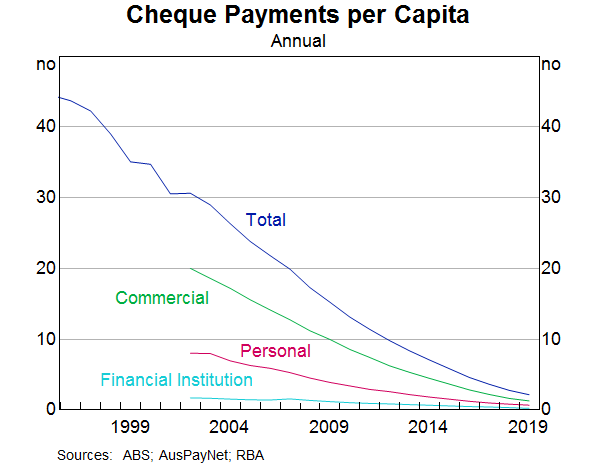
Third, is there a case for some rationalisation of Australia’s three domestically focused payment schemes, namely BPAY, eftpos and NPPA? A number of industry participants have indicated to us that they face significant and sometimes conflicting investment demands from the three different entities. This raises the question of whether some consolidation or some form of coordination of investment priorities might be in the public interest.
Fourth, and finally, what are the implications for the regulatory framework of technology changes, new entrants and new business models?
The world of payments is moving quickly, with new technologies and new players offering solutions to longstanding problems. At the same time, expectations regarding security, resilience, functionality and privacy are continually rising. Meeting these expectations can be challenging, but doing so is critical to building and maintaining the trust that lies at the heart of effective payment systems. The entry of non-financial firms into the payments market also raises new regulatory issues. As part of the review, it would be good to hear how the regulatory system can best encourage a dynamic and innovative payments system in Australia that fully serves the needs of its customers.


